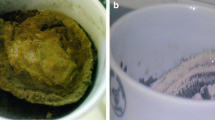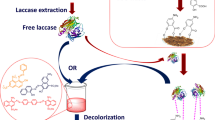Abstract
A total of three fungal isolates from samples collected at spent wash disposal area were screened for their ability to degrade melanoidin. Distillery molasses spent wash was decolorized, and its chemical oxygen demand (COD) was reduced in immobilized fungal bioreactor (IFB) in the absence of carbon and nitrogen source using fungal mycelia of Aspergillus oryzae MTCC 7691. Fungal mycelia immobilized on baggase packed in a glass column under a batch-wise mode (1) effected removal of 75.71 ± 0.12 % color, 51.0 ± 0.13 % biological oxygen demand (BOD), 86.19 ± 2.56 % COD, and 49.0 ± 0.12 % phenolic pigments of distillery spent wash up to 25 days at 30 °C, while free fungal mycelia resulted in removal of 63.1 ± 0.16 % color, 27.74 ± 0.14 % BOD, 76.21 ± 1.62 % COD, and 37.32 ± 0.17 % phenolic pigments of distillery spent wash using shake flask, (2) manganese peroxidase (MnP) activity was highest (1.55 ± 0.01 U ml−1 min−1) in immobilized fungi, followed by lignin peroxidase (0.65 ± 0.01 U ml−1 min−1) and laccase activity (0.9 ± 0.01 CU ml−1 min−1), (3) accumulative MnP activity was highly correlated with (r = 0.9216) spent wash decolorization and (r = 0.7282) reduction of phenolic pigments, suggesting the presence of MnP activities in bioremediation of spent wash and (4) degradation of spent wash was confirmed by high-performance thin layer chromatography and gas chromatography–mass spectrometry analysis. Measurement of chlorophyll a content of Chlorella species cultivated on treated spent wash effluent obtained from immobilized fungal bioreactor was 5.16 ± 0.71 μg ml−1 compared with 1.306 ± 0.017 μg ml−1 obtained with untreated spent wash. Thus, this work may provide a reasonable alternative for cost-effective bioremediation of distillery spent wash using immobilized A. oryzae on baggase fibers.








Similar content being viewed by others
References
Aggelis, G., Ethaliotis, C., Nerud, F., Stoychev, I., Lyberatos, G., & Zervakis, G. I. (2002). Evaluation of white-rot fungi for detoxification and decolorization of effluents from the green olive debittering process. Applied Microbiology and Biotechnology, 59(2–3), 353–360.
Andleeb, S., Atiq, N., Robson, G. D., & Ahmed, S. (2012). An investigation of anthraquinone dye biodegradation by immobilized Aspergillus flavus in fluidized bed bioreactor. Environmental Science and Pollution Research, 19(5), 1728–1737.
Arora, D. S., Chander, M., & Gill, P. K. (2002). Involvement of lignin peroxidase, manganese peroxidase and laccase in degradation and selective ligninolysis of wheat straw. International Biodeterioration & Biodegradation, 50(2), 115–120.
Bonugli-Santos, R. C., Durrant, L. R., & Sette, L. D. (2012). The production of ligninolytic enzymes by marine-derived basidiomycetes and their biotechnological potential in the biodegradation of recalcitrant pollutants and the treatment of textile effluents. Water, Air, and Soil Pollution, 223(5), 2333–2345.
Chairattanamanokorn, P., Imai, T., Kondo, R., Sekine, M., Higuchi, T., & Ukita, M. (2005). Decolorization of alcohol distillery wastewater by thermotolerant white-rot fungi. Applied Biochemistry and Microbiology, 41(6), 583–588.
Chaudhari, A. B., Dandi, N. D., Vadnere, N. C., Patil, U. K., & Chincholkar, S. B. (2012). Bioethanol: a critical appraisal. In T. Satyanarayana, B. N. Johri, & A. Prakash (Eds.), Microorganisms in sustainable agriculture and biotechnology (pp. 793–824). Berlin: Springer.
Chavan, M. N., Kulkarni, M. V., Zope, V. P., & Mahulikar, P. P. (2006). Microbial degradation of melanoidins in distillery spent wash by an indigenous isolate. Indian Journal of Biotechnology, 5(3), 416–421.
Dahiya, J., Singh, D., & Nigam, P. (2001). Decolorization of synthetic and spent wash melanoidins using white-rot fungus Phanerochaete chrysosporium JAG-40. Bioresource Technology, 78(1), 95–98.
Dandi, B. N., Dandi, N. D., Shelar, R. D., Chaudhari, A. B., & Chincholkar, S. B. (2010). Biological decolorisation of high concentration distillery spent wash using newly isolated microbial strains. Journal of Advances in Science and Technology, 13(2), 73–78.
Dandi, N. D., Dandi, B. N., & Chaudhari, A. B. (2013a). Bioprospecting of thermo- and osmo-tolerant fungi from mango pulp–peel compost for bioethanol production. Antonie van Leeuwenhoek, 103(4), 723–736.
Dandi, B. N., Dandi, N. D., Chaudhari, A. B. & Chincholkar, S. B. (2013b). Biodegradation of high gravity distillery effluent using microbes from different ecological habitats. Environmental Engineering and Management Journal (in press).
Dos Santos, V. C. G., De Souza, J. V. T. M., Tarley, C. R. T., Caetano, J., & Dragunski, D. C. (2011). Copper ions adsorption from aqueous medium using the biosorbent sugarcane bagasse in natura and chemically modified. Water, Air, and Soil Pollution, 216(1–4), 351–359.
Eaton, A. D., Franson, M. A. H., & American Public Health Association. (2005). Standard methods for the examination of water and wastewater. Washington, DC: American Public Health Association.
Fahy, V., FitzGibbon, F. J., McMullan, G., Singh, D., & Marchant, R. (1997). Decolorization of molasses spent wash by Phanerochaete chrysosporium. Biotechnology Letters, 19(1), 97–99.
Fitzgibbon, F. J., Nigam, P., Singh, D., & Marchant, R. (1995). Biological treatment of distillery waste for pollution-remediation. Journal of Basic Microbiology, 35(5), 293–301.
Ghosh, M., Ganguli, A., & Tripathi, A. K. (2002). Treatment of anaerobically digested distillery spent wash in a two-stage bioreactor using Pseudomonas putida and Aeromonas sp. Process Biochemistry, 37(8), 857–862.
Ghosh, M., Varma, S. C., Mengoni, A., & Tripathi, A. K. (2004). Enrichment and identification of bacteria capable of reducing chemical oxygen demand of anaerobically treated molasses spent wash. Journal of Applied Microbiology, 96(6), 1278–1286.
Guimarães, C., Porto, P., Oliveira, R., & Mota, M. (2005). Continuous decolourization of a sugar refinery wastewater in a modified rotating biological contactor with Phanerochaete chrysosporium immobilized on polyurethane foam disks. Process Biochemistry, 40(2), 535–540.
Henry, D. P., & Thomson, R. H. (1993). A new process to treat strong biological waste. Water Science and Technology, 27(1), 213–218.
Kaushik, G., & Thakur, I. S. (2013). Adsorption of colored pollutants from distillery spent wash by native and treated fungus: Neurospora intermedia. Environmental Science and Pollution Research, 20(2), 1070–1078.
Kim, S. J., & Shoda, M. (1999). Batch decolorization of molasses by suspended and immobilized fungus of Geotrichum candidum. Journal of Bioscience and Bioengineering, 88(5), 586–589.
Mielgo, I., Moreira, M. T., Feijoo, G., & Lema, J. M. (2002). Biodegradation of a polymeric dye in a pulsed bed bioreactor by Phanerochaete chrysosporium. Water Research, 36(7), 1896–1901.
Mohana, S., Desai, C., & Madamwar, D. (2007). Biodegradation and decolourization of anaerobically treated distillery spent wash by a novel bacterial consortium. Bioresource Technology, 98(2), 333–339.
Mohana, S., Acharya, B. K., & Madamwar, D. (2009). Distillery spent wash: treatment technologies and potential applications. Journal of Hazardous Materials, 163(1), 12–25.
Mohana, S., Acharya, B. K., & Madamwar, D. (2013). Bioremediation concepts for treatment of distillery effluent. In R. C. Kuhad & A. Singh (Eds.), Biotechnology for environmental management and resource recovery (pp. 261–278). India: Springer.
Ohmomo, S., Kainuma, M., Kamimura, K., Sirianuntapiboon, S., Aoshima, I., & Atthasampunna, P. (1988). Adsorption of melanoidin to the mycelia of Aspergillus oryzae Y-2-32. Agricultural and Biological Chemistry, 52(2), 381–386.
Pant, D., & Adholeya, A. (2007a). Biological approaches for treatment of distillery wastewater: a review. Bioresource Technology, 98(12), 2321–2334.
Pant, D., & Adholeya, A. (2007b). Enhanced production of ligninolytic enzymes and decolorization of molasses distillery wastewater by fungi under solid state fermentation. Biodegradation, 18(5), 647–659.
Raghukumar, C., Mohandass, C., Kamat, S., & Shailaja, M. S. (2004). Simultaneous detoxification and decolorization of molasses spent wash by the immobilized white-rot fungus Flavodon flavus isolated from a marine habitat. Enzyme and Microbial Technology, 35(2–3), 197–202.
Raghukumar, C., D'Souza-Ticlo, D., & Verma, A. K. (2008). Treatment of colored effluents with lignin-degrading enzymes: an emerging role of marine-derived fungi. Critical Reviews in Microbiology, 34(3–4), 189–206.
Singh, P., & Thakur, I. S. (2006). Colour removal of anaerobically treated pulp and paper mill effluent by microorganisms in two steps bioreactor. Bioresource Technology, 97(2), 218–223.
Singh, P. N., Robinson, T., & Singh, D. (2004). Distillery effluent. In A. Pandey (Ed.), Concise encyclopedia of bioresource technology (pp. 135–142). New York: Food Products Press Inc., Haworth Press.
Singh, K. D., Sharma, S., Dwivedi, A., Pandey, P., Thakur, R. L., & Kumar, V. (2007). Microbial decolorization and bioremediation of melanoidin containing molasses spent wash. Journal of Environmental Biology, 28(3), 675–677.
Singh, A., Bajar, S., Bishnoi, N. R., & Singh, N. (2010). Laccase production by Aspergillus heteromorphus using distillery spent wash and lignocellulosic biomass. Journal of Hazardous Materials, 176(1–3), 1079–1082.
Thakkar, A. P., Dhamankar, V. S., & Kapdnis, B. P. (2006). Biocatalytic decolorisation of molasses by Phanerochaete chrysosporium. Bioresource Technology, 97(12), 1377–1381.
Tiwari, S., Rai, P., Yadav, S. K., & Gaur, R. (2012). A novel thermotolerant Pediococcus acidilactici B-25 strain for color, COD, and BOD reduction of distillery effluent for end use applications. Environmental Science and Pollution Research 20(6), 4046–4058.
Verma, P., & Madamwar, D. (2002). Production of ligninolytic enzymes for dye decolorization by cocultivation of white-rot fungi Pleurotus ostreatus and Phanerochaete chrysosporium under solid-state fermentation. Applied Biochemistry and Biotechnology, 102–103(1–6), 109–118.
Wedzicha, B. L., & Kaputo, M. T. (1992). Melanoidins from glucose and glycine: composition, characterstics and reactivity towards sulphite ion. Food Chemistry, 43(5), 359–367.
Yadav, K. R., Chaudhari, A. B., Sharma, R. K., & Kothari, R. M. (2004). Preservation of bagasse by an alternative cost-effective and eco-friendly approach. Indian Journal of Chemical Technology, 11(5), 626–631.
Zhang, F., Knapp, J. S., & Tapley, K. N. (1999). Development of bioreactor systems for decolorization of Orange II using white rot fungus. Enzyme and Microbial Technology, 24(1–2), 48–53.
Acknowledgements
One of the first authors Chavan MS wish to acknowledge the assistance rendered by Dr. SK Singh, Agharkar Research Institute, Pune, India for identification of fungal isolates. Financial assistance from the University Grants Commission, New Delhi, as UGC-JRF in engineering and technology scheme to Chavan MS and to School of Life Sciences (SLS), North Maharashtra University (NMU), Jalgaon in the form of SAP-DRS program is also greatly acknowledged. The authors are also grateful to the Department of Science and Technology, New Delhi for support under FIST program to SLS, NMU, Jalgaon.
Author information
Authors and Affiliations
Corresponding author
Additional information
M. N. Chavan and N. D. Dandi contributed equally to this study as first authors
Electronic supplementary material
Below is the link to the electronic supplementary material.
ESM 1
(PDF 2827 kb)
Rights and permissions
About this article
Cite this article
Chavan, M.N., Dandi, N.D., Kulkarni, M.V. et al. Biotreatment of Melanoidin-Containing Distillery Spent Wash Effluent by Free and Immobilized Aspergillus oryzae MTCC 7691. Water Air Soil Pollut 224, 1755 (2013). https://doi.org/10.1007/s11270-013-1755-2
Received:
Accepted:
Published:
DOI: https://doi.org/10.1007/s11270-013-1755-2




